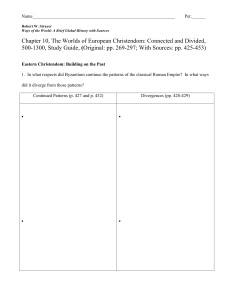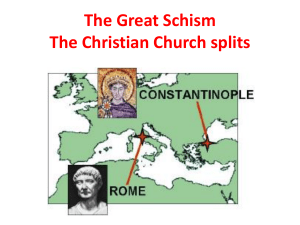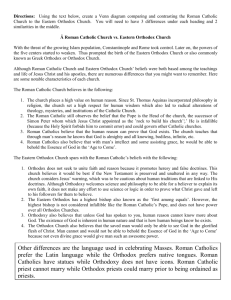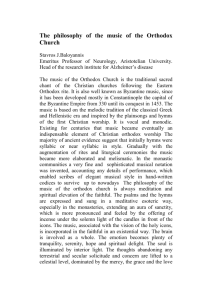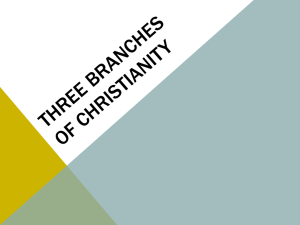Orthodox vs. Catholic Church: A Cultural & Theological Comparison
advertisement
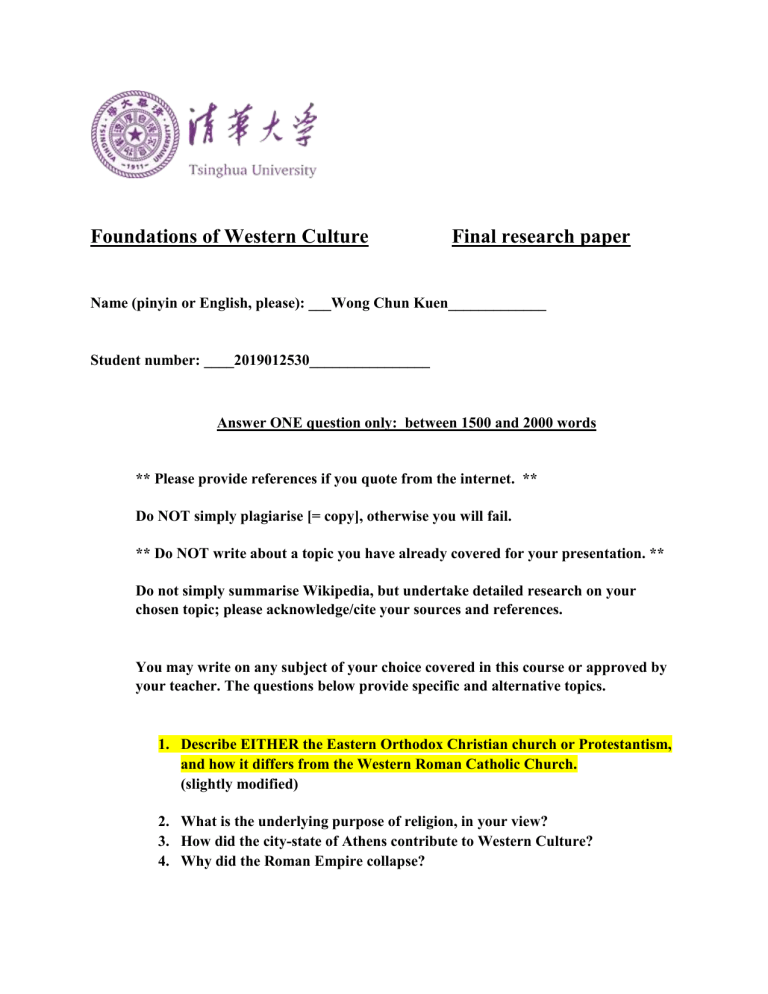
Foundations of Western Culture Final research paper Name (pinyin or English, please): ___Wong Chun Kuen_____________ Student number: ____2019012530________________ Answer ONE question only: between 1500 and 2000 words ** Please provide references if you quote from the internet. ** Do NOT simply plagiarise [= copy], otherwise you will fail. ** Do NOT write about a topic you have already covered for your presentation. ** Do not simply summarise Wikipedia, but undertake detailed research on your chosen topic; please acknowledge/cite your sources and references. You may write on any subject of your choice covered in this course or approved by your teacher. The questions below provide specific and alternative topics. 1. Describe EITHER the Eastern Orthodox Christian church or Protestantism, and how it differs from the Western Roman Catholic Church. (slightly modified) 2. What is the underlying purpose of religion, in your view? 3. How did the city-state of Athens contribute to Western Culture? 4. Why did the Roman Empire collapse? 5. Why do you think Dante placed ‘sinners’ in the order that he did, in his “Inferno”? 6. What was the most outstanding cultural contribution in EITHER the Middle Ages OR the Renaissance? 7. What makes an ideal state (and according to which thinker/s)? 8. What did Romanticism contribute in terms of politics? 9. Why, in your opinion, did Western civilisation overtake Chinese civilisation and how long will Western dominance continue? 10. Discuss the main currents in Western classical music from 1500 to the present. 11. Outline the course of the history of Europe between 1900 and 1991. In what ways could it have been different? 12. Is Dictatorship always bad, in your opinion? Give examples. Understanding the Differences between the Eastern Orthodox Church and the Roman Catholic Church and the Impacts on Civilizations Wong Chun Kuen School of Economics and Management, Tsinghua University A. Introduction For Chinese students studying the Western Civilization and Christianity, the Eastern Orthodox Church tends to be the most foreign and even puzzling one among the major three branches (Catholicism and Protestantism being the Figure 1: the cultural border of the Orthodox Civilization remaining two) , mainly due to the absence of efforts of Sinicization. As a student who spent 12 years in Christian education, among those 6 years were in a Anglican primary school and 6 years in a Jesuit secondary school, the first suggested topic in the final research paper document has intrigued me into completing the missing part in the Christian “puzzle” (figuratively). Since the first major schism in the Christendom happens between the Western Catholic Church and the Eastern Orthodox Church, this essay aims to discuss the differences between these two factions and has to leave out Protestantism due to the limit of length. In addition, by studying the Orthodox Church and the underlying civilization, it is hoped that we can have some insights about the civilization in today’s world and into the future. B. A Brief History of the Orthodox Church According to the New Testament, Peter, one of the twelve apostles, became the first Pope and established the Catholic Church as the governing body of Christianity. Christians had been spreading underground until when Constantine the Great became the Roman Emperor in AD 306. Being a baptized Christian, he helped proclaim the Edict of Milan in 313, which granted tolerance of Christianity in the Empire. 10 years later, Christianity became the official religion of the Empire. In 395, the Empire experienced the permanent divide, the Western Roman Empire ended in 476. In 751, the Eastern Roman Empire withdrew from Rome and never returned. As generations passed, the linguistic division between the Latin speaking Roman Church and the Greek speaking Constantinople Church, coupled with the geographic separation, finally escalated into the Great Schism of 1054 in which the Orthodox Church claimed independence from the Catholic Church. Although Constantinople was eventually fallen in 1453, the Russian Church resumed the leadership of the Orthodox Church, and the Moscow was claimed as the “third Rome”, emphasizing its legitimacy. C. Theological Comparison This section will examine three major theological differences between the Orthodox Church and the Roman Catholic Church, namely papal primacy, the view on the Holy Trinity and the status of Virgin Mary. i. Papal Primacy The Papal Primacy is the most direct factor for the Great Schism. The Catholic Church granted the Papal Primacy “full, supreme, and universal power over the whole Church” 1. On the other hand, the Orthodox Church merely perceives the Pope as the “first among equals” with much prestige, but without practical executive power over other churches, therefore, when witnessing the Catholic Church exercising the overarching executive power, discontent grew. Eventually, the disagreement manifested in the Great Schism which means the Orthodox Church permanently exited the direct influence of the Pope. ii. Holy Trinity: the status of the Holy Son and the Holy Spirit According to the lectures and the teaching materials, Christians believe in the Holy Trinity, i.e. both the Holy Father, Holy Son and the Holy Spirit is God, and those who do not believe so are generally categorized as heresy. However, there is controversy in the relative significance of them. Dr Ralph Lee of the University of Cambridge’s Faculty of Divinity explained that the Orthodox Church upholds the view that the Holy Spirit “proceeds from God the Father”, in contrast to the Catholic view which sees the Holy Spirit “proceeds from the Father and the Son”2, this is known as the filioque clause. The Catholic Church officially accepted the clause in 1014 but is subsequently rejected by the Orthodox Church. The critics of the Catholic interpretation argue that such underestimates the authority of the Holy Father, while the Catholic proponents deem the Orthodox version as demeaning to the Holy Son’s role. iii. Original Sin and the Immaculate Conception of Mary The Catholic Church has the proposition of Immaculata Conceptio, which states that God granted grace to Virgin Mary when she was conceived, therefore she did not bare the original sin. 3 Such proposition was made official by the Catholic Church in December 8, 18544. 1 Catechism of the Catholic Church (2nd ed.). Paragraph 882. Jones, Walker 2008 3 Coyle 1996, p. 36. 4 Wright 1992, p. 237. 2 The Eastern Orthodox Church did not approve Augustine’s proposition of the original sin from the very beginning5, therefore logically the presumption for Immaculata Conceptio never existed in the Orthodox doctrine, although they still respect Mary by including in its liturgy. In fact, the Orthodox Patriach Anthimus VII of Constantinople described the idea of Immaculata Conceptio as “Roman novelties”.6 D. Political and Cultural Comparison After an examination of the theological divide, the probably more intriguing and certainly more relatable section about their respective political and cultural influences on their civilization shall be discussed. Two aspects concerning the church-state relationship, relationship with individualism and collectivism are chosen. i. Church-State Relationship In Western Europe, due to the rise of strong monarchs like the “Sun King”, Louie the Fourteenth of France (which is a Catholic state) and Henry the Eighth of England who created Anglicanism and left the Catholic Church, the secular power of the Catholic Church was seized, but the Church’s intellectual and spiritual power remained. This created a check-and-balance mechanism between them. The contest between them eventually manifested into the separation of church and state. Meanwhile, as the intellectuals were not consolidated into one single block, there was room for free thinking. On the other hand, in the Orthodox world, the Church is subservient to the state. The secular monarch assigned the Patriarchs to the Churches and they formed an de facto ruling alliance. The impact could not be so worse if the Mongol rule did not leave such a remarkable scar in the Orthodox civilization. Typically, a nomadic tribe merges into the defeated people, such as the Yuan Dynasty which largely adopted Chinese bureaucracy and ceremonial system. However in the Russian case, the Russian ruling class became as brutal as the Mongols if not even more oppressive after the Mongols were expelled. They locked the serfs into the land and taxed heavily on them while the peasants’ Western European Counterpart enjoyed higher wages, opportunity to move into the city and better social bargaining power against their overlords. The Eastern Orthodox Church could not deny their collusion with the brutal ruling class. In summary, the church-state relationship in the Catholic world is partly competitive in the secular life and partly cooperative in the spiritual life, but the Orthodox Church was just a proxy of the Russian State. ii. Development of Individualism and Collectivism The Roman Catholic Church abolished cousin marriage which was crucial in undermining the clans’ power in the Western European society. This is one important 5 6 MuGuckin 2010 Meyendorff 1981, p. 90. presumption for the development of individualism and personal freedom because people can get rid of the control of their clans. Conversely, the geopolitics of the Orthodox world made the Church a center for the development of collectivism. Since the Eastern Roman Empire faced aggression from all sides of its border, the people were extraordinary loyal to the Church-State complex because otherwise they might be enslaved by a certain group of Figure 2: the map of the index of Collectivism-Individualism invaders. The Orthodox Church never attempted the same level social reengineering like the Catholic Church’s ban on cousin marriage because there was strong and immediate need for a high degree of internal cohesion despite all the oppression by the ruling class. In short, the Orthodox Church did not have the luxury as the Catholic Church to break down clans’ dominance in society, the Orthodox world remains the most collective civilization in the entire Western world. E. Reflections and Afterthoughts The prospect for the modern orthodox civilization is dim, the leading nation, Russia’s economy is stagnating, performs terribly compare to countries with similar population in spite of all the natural resources, the demographic is shrinking. These might not be strictly within the boundary of the assigned question, but the study of history is the study of the accumulation of human behavior. The root of the phenomenon lies partly in the culture of Orthodox civilization which was shaped by no other than the church itself. F. References Blum, Jerome(1961). Lord and peasant in Russia: from the ninth to the nineteenth century. Princeton, N.J. : Princeton University Press, 1972. Catechism of the Catholic Church (2nd ed.). Libreria Editrice Vaticana. 2019. Paragraph 882. Coyle, Kathleen (1996). Mary in the Christian Tradition: From a Contemporary Perspective. Gracewing Publishing. ISBN 9780852443804. Jones, Walker (2018) “What is the Orthodox Church?” Deutsche Welle. Retrieved January 1, 2022. Meyendorff, Jean (1981). The Orthodox Church: Its Past and Its Role in the World Today. St Vladimir's Seminary Press. ISBN 9788178354569. McGuckin, John Anthony (2010). The Orthodox Church: An Introduction to its History, Doctrine, and Spiritual Culture. John Wiley & Sons. ISBN 9781444393835. Riasanovsky, N. V., & Steinberg, M. D. (2019). A History of Russia. Wright, David F. (1992). "Mary". In McKim, Donald K.; Wright, David F. (eds.). Encyclopedia of the Reformed Faith. Westminster John Knox Press. ISBN 9780664218829.

